Z-Language Report: Container Terminal Operations using Z Notation
VerifiedAdded on 2023/06/05
|9
|789
|62
Report
AI Summary
This report provides a detailed analysis of container terminal operations using the Z-Language for formal specification. It covers various operations such as initialization, entering new container terminals, accepting deliveries and pickups, managing delivery queues, unloading ships, and managing container terminal, ship, and freight company accounts. The report uses Z-schemas to describe the states and state changes associated with each operation, distinguishing between operations that modify the system state and those that provide read-only access to data. It highlights the importance of data refinement and constraints, such as limiting the number of vehicles per delivery, and references academic literature on the Z Notation.

Running head: Z-LANGUAGE
Z-Language
Name of the Student
Name of the University
Author’s note:
Z-Language
Name of the Student
Name of the University
Author’s note:
Paraphrase This Document
Need a fresh take? Get an instant paraphrase of this document with our AI Paraphraser
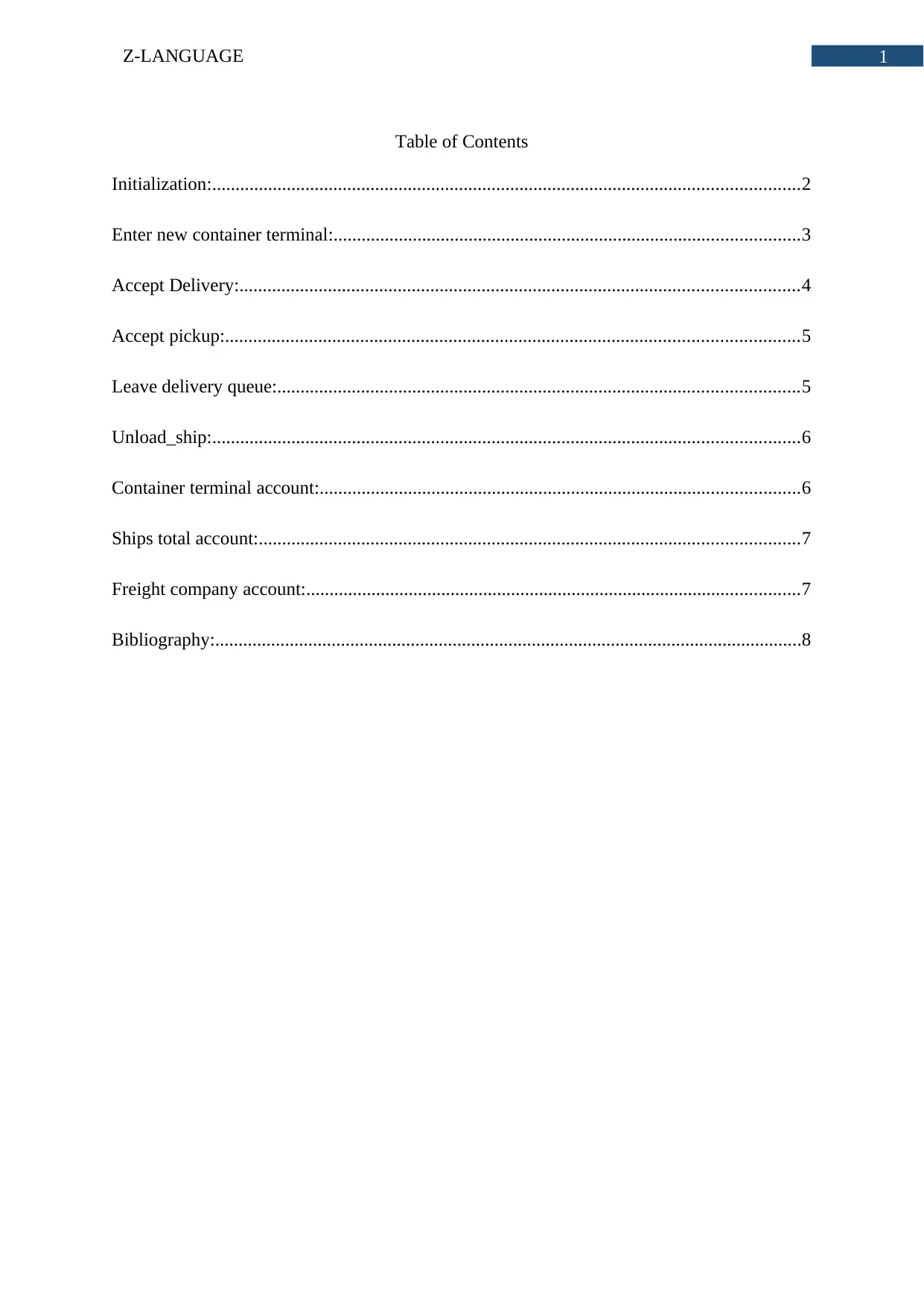
1Z-LANGUAGE
Table of Contents
Initialization:..............................................................................................................................2
Enter new container terminal:....................................................................................................3
Accept Delivery:........................................................................................................................4
Accept pickup:...........................................................................................................................5
Leave delivery queue:................................................................................................................5
Unload_ship:..............................................................................................................................6
Container terminal account:.......................................................................................................6
Ships total account:....................................................................................................................7
Freight company account:..........................................................................................................7
Bibliography:..............................................................................................................................8
Table of Contents
Initialization:..............................................................................................................................2
Enter new container terminal:....................................................................................................3
Accept Delivery:........................................................................................................................4
Accept pickup:...........................................................................................................................5
Leave delivery queue:................................................................................................................5
Unload_ship:..............................................................................................................................6
Container terminal account:.......................................................................................................6
Ships total account:....................................................................................................................7
Freight company account:..........................................................................................................7
Bibliography:..............................................................................................................................8

2Z-LANGUAGE
Initialization:
Initialization:
⊘ This is a preview!⊘
Do you want full access?
Subscribe today to unlock all pages.

Trusted by 1+ million students worldwide

3Z-LANGUAGE
All the global variables used in the software coding is initialized at the beginning of
the operations. The Z states which will consist of the variables are declared at the
initialization process. The variable has some value range. The purpose of the initialization is
understanding the nature of the variable like is it a natural number or set of characters and its
value range. Taken as an example, the active truck number for a delivery cannot be more than
5. Initialization process does not have any impact on the variables and states.
Enter new container terminal:
Enter new terminal means that the system will record a new terminal to the database.
This operation is used to add a new value therefore the Z describes change of state. The
abstract collection of data has been altered for achieving data refinement in the terminal data
collection. The terminal name is the data which allows the database to find each terminal
uniquely. The storing capacity of container means how much load it can hold. It is measured
through weight and quantity delivered by each truck.
All the global variables used in the software coding is initialized at the beginning of
the operations. The Z states which will consist of the variables are declared at the
initialization process. The variable has some value range. The purpose of the initialization is
understanding the nature of the variable like is it a natural number or set of characters and its
value range. Taken as an example, the active truck number for a delivery cannot be more than
5. Initialization process does not have any impact on the variables and states.
Enter new container terminal:
Enter new terminal means that the system will record a new terminal to the database.
This operation is used to add a new value therefore the Z describes change of state. The
abstract collection of data has been altered for achieving data refinement in the terminal data
collection. The terminal name is the data which allows the database to find each terminal
uniquely. The storing capacity of container means how much load it can hold. It is measured
through weight and quantity delivered by each truck.
Paraphrase This Document
Need a fresh take? Get an instant paraphrase of this document with our AI Paraphraser
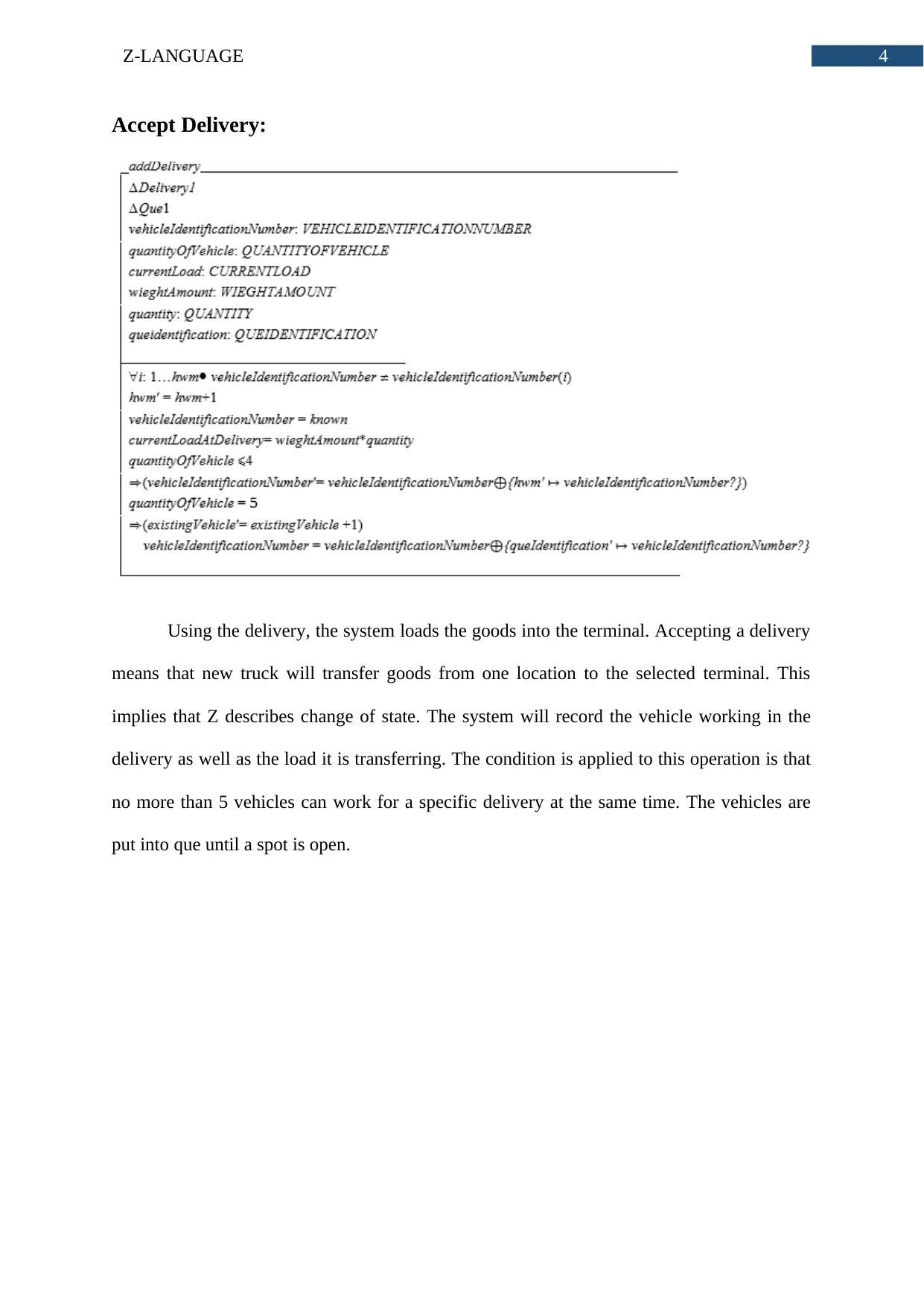
4Z-LANGUAGE
Accept Delivery:
Using the delivery, the system loads the goods into the terminal. Accepting a delivery
means that new truck will transfer goods from one location to the selected terminal. This
implies that Z describes change of state. The system will record the vehicle working in the
delivery as well as the load it is transferring. The condition is applied to this operation is that
no more than 5 vehicles can work for a specific delivery at the same time. The vehicles are
put into que until a spot is open.
Accept Delivery:
Using the delivery, the system loads the goods into the terminal. Accepting a delivery
means that new truck will transfer goods from one location to the selected terminal. This
implies that Z describes change of state. The system will record the vehicle working in the
delivery as well as the load it is transferring. The condition is applied to this operation is that
no more than 5 vehicles can work for a specific delivery at the same time. The vehicles are
put into que until a spot is open.
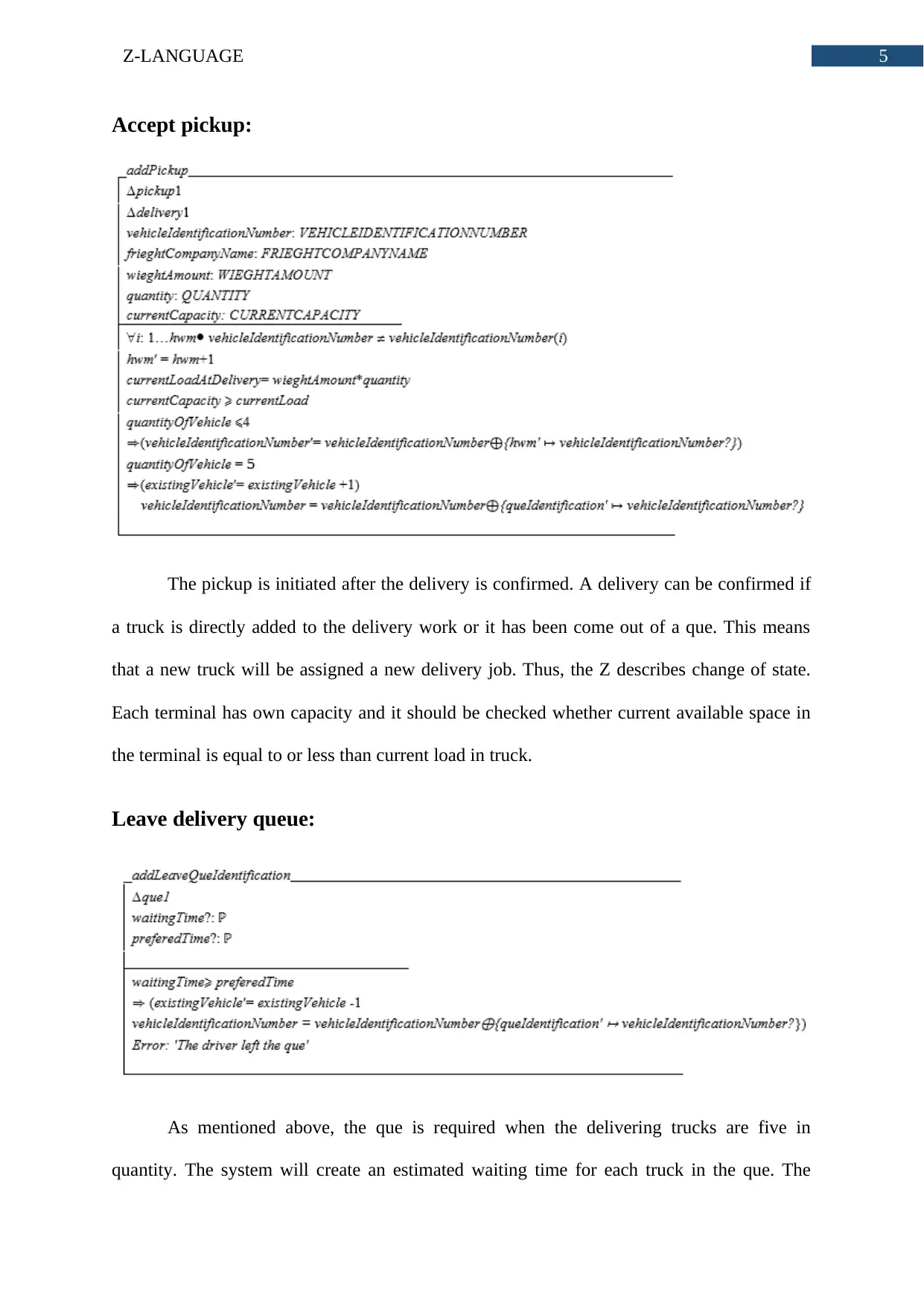
5Z-LANGUAGE
Accept pickup:
The pickup is initiated after the delivery is confirmed. A delivery can be confirmed if
a truck is directly added to the delivery work or it has been come out of a que. This means
that a new truck will be assigned a new delivery job. Thus, the Z describes change of state.
Each terminal has own capacity and it should be checked whether current available space in
the terminal is equal to or less than current load in truck.
Leave delivery queue:
As mentioned above, the que is required when the delivering trucks are five in
quantity. The system will create an estimated waiting time for each truck in the que. The
Accept pickup:
The pickup is initiated after the delivery is confirmed. A delivery can be confirmed if
a truck is directly added to the delivery work or it has been come out of a que. This means
that a new truck will be assigned a new delivery job. Thus, the Z describes change of state.
Each terminal has own capacity and it should be checked whether current available space in
the terminal is equal to or less than current load in truck.
Leave delivery queue:
As mentioned above, the que is required when the delivering trucks are five in
quantity. The system will create an estimated waiting time for each truck in the que. The
⊘ This is a preview!⊘
Do you want full access?
Subscribe today to unlock all pages.

Trusted by 1+ million students worldwide
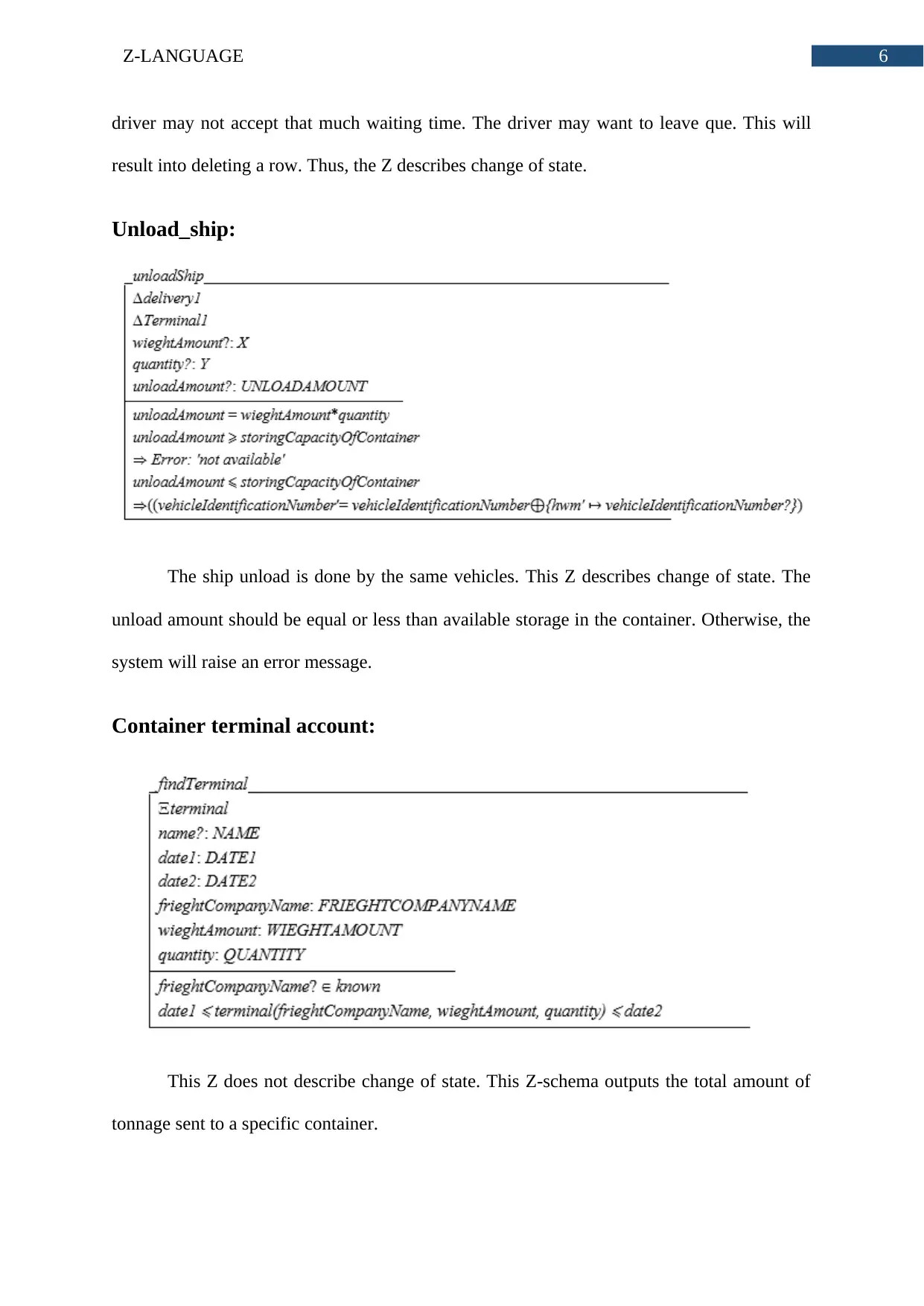
6Z-LANGUAGE
driver may not accept that much waiting time. The driver may want to leave que. This will
result into deleting a row. Thus, the Z describes change of state.
Unload_ship:
The ship unload is done by the same vehicles. This Z describes change of state. The
unload amount should be equal or less than available storage in the container. Otherwise, the
system will raise an error message.
Container terminal account:
This Z does not describe change of state. This Z-schema outputs the total amount of
tonnage sent to a specific container.
driver may not accept that much waiting time. The driver may want to leave que. This will
result into deleting a row. Thus, the Z describes change of state.
Unload_ship:
The ship unload is done by the same vehicles. This Z describes change of state. The
unload amount should be equal or less than available storage in the container. Otherwise, the
system will raise an error message.
Container terminal account:
This Z does not describe change of state. This Z-schema outputs the total amount of
tonnage sent to a specific container.
Paraphrase This Document
Need a fresh take? Get an instant paraphrase of this document with our AI Paraphraser
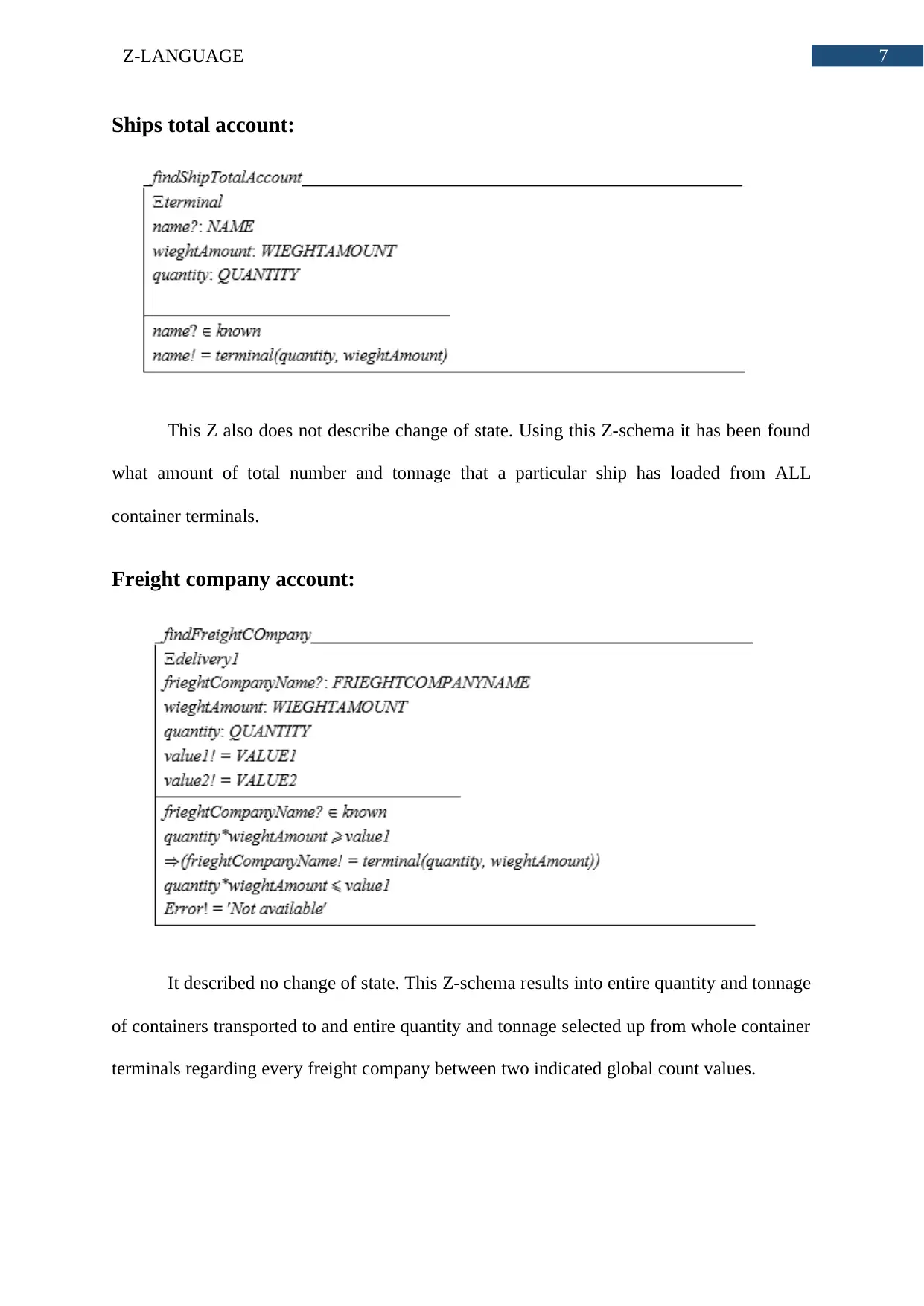
7Z-LANGUAGE
Ships total account:
This Z also does not describe change of state. Using this Z-schema it has been found
what amount of total number and tonnage that a particular ship has loaded from ALL
container terminals.
Freight company account:
It described no change of state. This Z-schema results into entire quantity and tonnage
of containers transported to and entire quantity and tonnage selected up from whole container
terminals regarding every freight company between two indicated global count values.
Ships total account:
This Z also does not describe change of state. Using this Z-schema it has been found
what amount of total number and tonnage that a particular ship has loaded from ALL
container terminals.
Freight company account:
It described no change of state. This Z-schema results into entire quantity and tonnage
of containers transported to and entire quantity and tonnage selected up from whole container
terminals regarding every freight company between two indicated global count values.

8Z-LANGUAGE
Bibliography:
Bowen, J. P. (2016). The Z Notation: Whence the Cause and Whither the Course?. In
Engineering Trustworthy Software Systems (pp. 103-151). Springer, Cham.
Klein, M. J., Sawicki, S., Roos-Frantz, F., & Frantz, R. Z. (2014, April). On the
Formalisation of an Application Integration Language Using Z Notation. In ICEIS (1)
(pp. 314-319).
Bibliography:
Bowen, J. P. (2016). The Z Notation: Whence the Cause and Whither the Course?. In
Engineering Trustworthy Software Systems (pp. 103-151). Springer, Cham.
Klein, M. J., Sawicki, S., Roos-Frantz, F., & Frantz, R. Z. (2014, April). On the
Formalisation of an Application Integration Language Using Z Notation. In ICEIS (1)
(pp. 314-319).
⊘ This is a preview!⊘
Do you want full access?
Subscribe today to unlock all pages.

Trusted by 1+ million students worldwide
1 out of 9
Related Documents
Your All-in-One AI-Powered Toolkit for Academic Success.
+13062052269
info@desklib.com
Available 24*7 on WhatsApp / Email
![[object Object]](/_next/static/media/star-bottom.7253800d.svg)
Unlock your academic potential
Copyright © 2020–2025 A2Z Services. All Rights Reserved. Developed and managed by ZUCOL.




